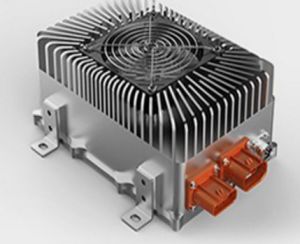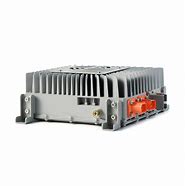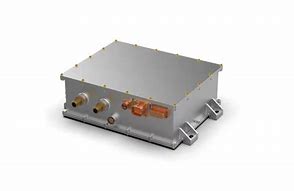Over the past few years, your local gas station may have gotten a bit of an upgrade. As more and more electric vehicles merge onto the highway toward 2030 and beyond, EV charging stations are popping up from coast to coast. But how could the same stuff that makes your electric toothbrush buzz be what powers a two-ton vehicle from 0–60 MPH in total silence? Here’s how electric vehicle charging stations work — and how EV Connect can help them work for your business.
Power Structure
EV technology has existed since the 1800s, and the basics of those early electric vehicles are not too dissimilar from where we are today. A rack of rechargeable fuel cells provided the power to spin the wheels and propel the car forward, and many early EVs could be charged by the same electrical outlets that powered certain lights and appliances in turn-of-the-century homes.
While it may be hard to imagine a battery-powered car at a time when the main source of road traffic was horse-drawn carriages, the truth is that the earliest innovators of motorcars experimented with all kinds of propulsion systems, from pedals and steam to batteries and liquid fuel. In many ways, it seemed like EVs had pole position in the race to mass production because they didn’t require massive water tanks and heating systems to create steam, and didn’t belch fumes and blast out noise like gasoline engines.

A Century-Long Pitstop
However, EVs ended up losing the race for a variety of factors. The discovery of vast oil fields in places like Texas made gasoline cheaper and more available than ever before, and improved roads and highway infrastructure meant drivers could leave their neighborhoods and head out on the open road. While gas stations could spring up almost anywhere, electricity remained a rarity in areas outside major cities. Gasoline took the checkered flag, while EVs declined in popularity for most of the 20th century.
Fast as Lightning
How do electric vehicle charging stations work today? Fundamentally, not much has changed: A plug goes into the charging port on the vehicle, with the other end hooks up to an electrical outlet — in many cases, the same one that powers a home’s lights and appliances. Of course, decades of modern advancements in technology and engineering have made the process easier and vastly more efficient.
There are three main types of chargers based on the output each provides. Level 1 chargers use the same standard 120 V outlets you find in homes and personal garages, and can add up to 5 miles of range per hour of charging — perfect for a commuter who lives a short distance from their office and can let their vehicle charge overnight at the end of each work day. Level 2 chargers provide up to 20 miles of range per hour of charging, but require extra equipment to handle higher-capacity 240 V residential outlets and 208 V commercial outlets like you have at your office building or complex.
DC Fast Chargers, however, can juice your EV at a rate of 80 miles of range per 20 minutes of charging. That’s a huge improvement over the other levels, so it’s no surprise that these special stations use higher-capacity 480 V AC inputs with advanced technology and equipment in both the charging station and the vehicle itself. These are the kinds of EV stations you may spot alongside major thoroughfares and highly trafficked routes like California’s Interstate 5.

Batteries Included
Electric vehicle charging stations work by harnessing electricity from one of several sources, then distributing that power to your vehicle. Depending on an EV’s make and model, there are a few standard plugs and corresponding vehicle outlets and battery types, but generally speaking, an EV uses electrical energy stored in its fuel cells to power a motor that physically spins the wheels — just like those old Victorian-era vehicles.
Once the EV has had its fill of electricity, the range will depend on the specifications of your ride. More batteries can supply more power, but they also create more weight that the engine will need extra power to overcome. Fewer batteries can make for lower curb weight and more-efficient driving, albeit with a much shorter range and a slower recharge time that can make longer trips more challenging.
Electric Avenue
More than 100 years after the first introduction of electric vehicles , infrastructure and technology is catching up and ready to support the proliferation of electric vehicles. Technological advancements in battery efficiency and design allow modern EVs to go hundreds of miles on a single charge. As gas stations, garages, retail centers and governments invest in infrastructure, the growing network of charging stations across the country is allowing EV drivers to extend their range even further. With more than 18 million EVs in 350-plus different models expected on the road by 2030, we should see many more EV charging stations in even further-flung locations over the next decade.
Power Management
With greater demand for electric charging, businesses looking to provide their customers with different charging options will have to invest in equipment and software — and fast, before they are left in the dust. With all the various levels of charging and dozens of charging station manufacturers, catching up to consumer needs in just a few short years may seem daunting. That’s where evlithiumcharger comes in. Our charging solutions provide clients with a full suite of tools to plan, deploy, test, manage and maintain their charging stations.
Evlithium charger is designed to help apartment buildings supply a spark for their residents, give dispatchers a scalable solution for their fleets of taxis or buses, or let retail centers provide a convenient service for their customers. If either client or customer needs troubleshooting or is still a little unclear about how their electric vehicle charging stations work, evlithiumcharger is available 24/7 to answer any questions.

Next:7 Reasons Why Autumn Is a Great Time to Install a Home EV Charger
Previous:Level 2 vs. Level 3 EV Charging Stations: What’s Right for You?
Contact Person: Miss. Kiki
| WhatsApp : | +8617763224709 |
|---|---|
| Skype : | +8617763224709 |
| WeChat : | +8617763224709 |
| Email : | kiki@lifepo4-battery.com |